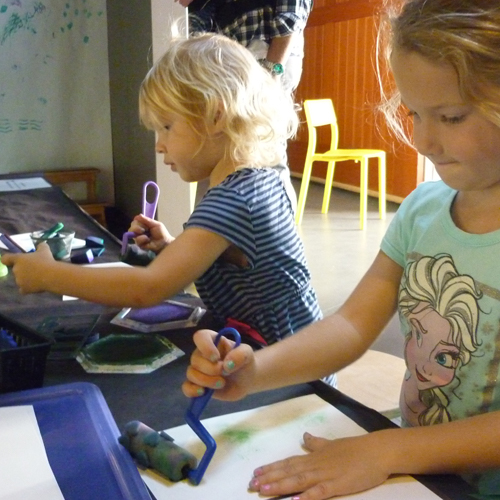Children design and create a stamp that represents their own individual signature.
Materials Required
- Pre-made signature stamps for inspiration (optional)
- Small pieces of white paper, one per child
- Small mirrors
- Pencils
- Scratch foam
- Scissors
- Brayer or rubbing tool
- Paint
- Large piece of white paper
Instructions
- Introduce and discuss the idea of an individual “signature” if children are not familiar with this concept. Show some examples of signature stamps and discuss professions that might use them (e.g. doctors, lawyers).
- Challenge children to design their own signature stamp. Provide them with blank paper to try out some ideas and make plans first. Encourage them to come up with a unique way to sign their own name, and a shape to surround it that represents something important about their identity: for example, a dog or a soccer ball.
- Encourage children to try out many different signature styles; they are not stuck with the first thing that comes to mind.
- Remind children of the reverse imagery required for stamping. Provide time and blank paper so they can practice reversing their signature. Pass out mirrors to support this process.
- Use a pencil to draw the shape onto the scratch foam and scissors to cut it out.
- Use a pencil to sign your name inside your shape on the scratch foam.
- Dip the brayer or rubbing tool in paint, the cover your signature stamp with paint. Try out the stamp on paper!
- Use the large piece of paper for a collaborative group mural with all of the signature stamps.
Additional Tips
Try these add-on activities:
- Invite younger children to first explore stamping in a novel way by using natural and recycled materials dipped in paint to stamp the paper, and by creating stamps of shapes or images instead of letters.
- Support children’s reflection of how the stamp worked in ways they expected or were surprised by. Encourage them to think about reverse imagery.
- Invite children to design and create a base and handle for their stamp using recycled materials and pipe cleaners, then glue the stamp to the base.
- Encourage children to think about signatures beyond just the letters in their names. What symbols could be used? How are logos similar to or different from a signature?


